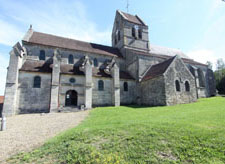Coulonges-Cohan (Aisne, France) - Saints-Rufin-et-Valère
- Disclaimer
The dating found here is based on the work of John James, and is meant on this site to serve as a starting point. James' dating is derived from a system that uses his interpretation of the development of capitals over time as the basis for chronology, among other factors. His goal is to refine the dating to within years rather than decades. I have not fully embraced James' methodology, and will be developing this page from its current state to one which is admittedly more conservative. The relative expenditure values found in the Timeline are also based on James' work, and I believe these to be reasonably reliable. They are intended only to give a sense of the amount of work involved in each decade.
I have added the idea of the "project" as a way of separating work in buildings. In my mind, a "project" is a discrete section of work in a building that resulted from the one-time acquisition of funding. "Projects" are generally separated by at least a decade where no work was being done. It is my view that it would have been unwise to start a "project" that could not be finished and protected from the elements, and as such a "project" usually involved a wing or multiple wings of a building, from floor to roof. Rural churches, which could only secure small amounts of funding at irregular intervals, often were the result of many small projects, while the great churches, which benefitted from relatively consistent funding, may have involved only a few large projects.
I have added the idea of the "project" as a way of separating work in buildings. In my mind, a "project" is a discrete section of work in a building that resulted from the one-time acquisition of funding. "Projects" are generally separated by at least a decade where no work was being done. It is my view that it would have been unwise to start a "project" that could not be finished and protected from the elements, and as such a "project" usually involved a wing or multiple wings of a building, from floor to roof. Rural churches, which could only secure small amounts of funding at irregular intervals, often were the result of many small projects, while the great churches, which benefitted from relatively consistent funding, may have involved only a few large projects.
- Timeline with Relative Expenditure (if available, in building units)
 |
 |
 |
 |
 |
 |
 |
 |
- Project A - 1080s - Phase 1 - crossing (a)
Crossing piers with buttresses to outside; project 92cm on south but had to be cut back on the north by 30cm to get the same width opening; details confusing, and sizes suggest could have been built in two stages; seem to be marks left by the wall of the earlier apse in centre of these piers;
- Project A - 1090s - Phase 2 - crossing (d)
Crossing n-n wall with dado
- Project A - 1100s - Phase 3 - s crossing
Crossing s-s wall, no dado; seems built with crossing by the time the tower got to height of west arch;
- Project A - 1110s - Phase 4 - crossing (c)
Clerestory string and caps, and pointed barrel vault and external buttresses to each side; apse was demolished when choir built;
- Project A - 1120s - Phase 5 - tower I
Tower I with no openings;
- Project A - 1130s - Phase 6 - tower II
Tower II
- Project B - 1150s - Phase 7 - nave (b)
Nave bases all round to 2 courses above door entry which is 1 course below capitals; bases now buried 2 courses below present floor; w-w door begun; pilaster piers a little like Cohan; windows built with walls, 770 wide; complex arches over entry into crossing aisles; the north was generally ahead of the south from arch keystones;
- Project B - 1150s - Phase 8 - nave (a)
Nave capitals including west door, arches and vaults begun and window arches;
- Project B - 1160s - Phase 9 - nave (av)
Rest of walls, cornice, aisle vaults; probably string course and start clerestory windows;
- Project B - 1160s - Phase 10 - nave (c)
Nave clerestory capitals, window sills, and start to vaults; includes caps added to w1 on west side;
- Project C - Later - Phase 11 -
Flyers and enlarged buttresses to nave; choir rebuilt
